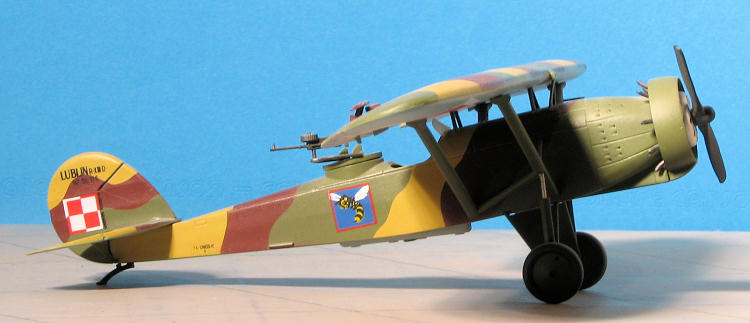
Spojnia 1/48 Lublin R.XIIID
| KIT #: | 1 |
| PRICE: | about $10 1990 dollars |
| DECALS: | Several options |
| REVIEWER: | Scott Van Aken |
| NOTES: | Kit built in 1991 |

| HISTORY |
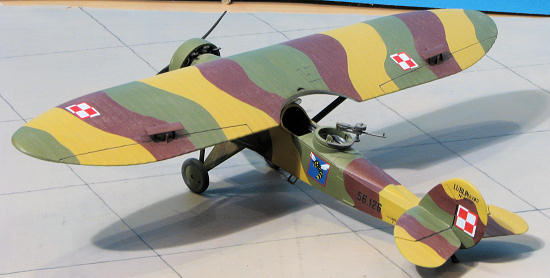 The
Lublin R-XIII was the Polish army-cooperation plane (observation and liaison
plane), designed in the early-1930s in the Plage i Laśkiewicz factory in Lublin.
It was the main army cooperation plane in the Invasion of Poland. Its variant
Lublin R-XIV was a military trainer aircraft.
The
Lublin R-XIII was the Polish army-cooperation plane (observation and liaison
plane), designed in the early-1930s in the Plage i Laśkiewicz factory in Lublin.
It was the main army cooperation plane in the Invasion of Poland. Its variant
Lublin R-XIV was a military trainer aircraft.
In the early 1930s the R-XIII was quite a successful plane for its purpose. It had a very short take-off (68 m for R-XIIIA) and landing, enabling it to operate from fields and meadows. However, only some of R-XIIIs were equipped with a radio and a camera, which lowered their usefulness. In 1932-1936 they were used in three-aircraft liaison platoons, being a basic Polish army-cooperation plane. In 1937 they were formed into army-cooperation escadres (eskadra towarzysząca), in 1939 reformed into observation escadres (eskadra obserwacyjna). Only in 1939, part of R-XIII were replaced by the RWD-14b Czapla, which was not much more modern. A planned replacement was a modern LWS-3 Mewa, but it was not introduced due to war outbreak.
On the eve of the Invasion of Poland in 1939, the Polish Air
Force had about 150 R-XIII. Of them, 49 were in combat units, 30 in reserve,
about 30 in training units and about 40 in repairs. In combat units, R-XIII were
used in 7 observation escadres (out of 12): numbers 16, 26, 36, 43, 46, 56 and
66. Each escadre had 7 aircraft. The 16th Escadre was in C-in-C reserve, while
the others were distributed among the field Armies. The R-XIII was no match for
any of the Luftwaffe fighters, bombers or even reconnaissance ai rcraft,
being much slower, and armed with only one machine gun, but they were actively
used for close reconnaissance and liaison tasks.
rcraft,
being much slower, and armed with only one machine gun, but they were actively
used for close reconnaissance and liaison tasks.
About 40 R-XIII from combat units were destroyed during the campaign, but only part of those were shot down by the German aircraft or flak. During the campaign, 9 aircraft were given to observation escadres as replenishment. Some planes were also used in a wartime improvised units in air bases. About 10 combat aircraft and 7 from other units were withdrawn to Romania. A number of aircraft were bombed by the Germans in air bases or burned by withdrawing Poles. None have survived to today.
In the Naval Air Squadron, 11 R-XIIIter and R-XIIIG floatplanes were used in 1939. One of them made a night bombing raid on Danzig on September 7, searching in vain for the Schleswig-Holstein. On September 8 all planes were bombed, while stationed on the sea near Hel on the Hel Peninsula.
| THE KIT |
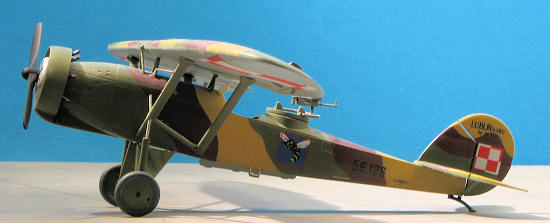 It has
been twenty years since I built this kit, so in the box info is rather minimal,
as you might imagine. I can tell you that it came with floats to do the naval
version and that the detailing and condition of the plastic was very good. No
sink areas to speak of, no flash and minimal ejector pin markings. The 'hills
and valleys' fabric effect may be a bit much for some, but it looks OK to me.
The decal sheet provided markings for several aircraft. I'm not really sure if
this is the same kit that has been recently issued by Mirage, but I'd be
surprised if it wasn't. It is a good one even at today's standards so if you see
it, you may want to pick it up.
It has
been twenty years since I built this kit, so in the box info is rather minimal,
as you might imagine. I can tell you that it came with floats to do the naval
version and that the detailing and condition of the plastic was very good. No
sink areas to speak of, no flash and minimal ejector pin markings. The 'hills
and valleys' fabric effect may be a bit much for some, but it looks OK to me.
The decal sheet provided markings for several aircraft. I'm not really sure if
this is the same kit that has been recently issued by Mirage, but I'd be
surprised if it wasn't. It is a good one even at today's standards so if you see
it, you may want to pick it up.
| CONSTRUCTION |
 Construction
was relatively trouble-free. I built this one right from the box and didn't add
anything extra to it. Parts fit well and provided little construction trauma.
The interior is fairly well appointed and there is framework detailing on the
inside of the fuselage halves. I used Reheat instrument decals to spruce up the
main panel and it really does add to it. No belts, unfortunately, but not
something that detracts from the build.
Construction
was relatively trouble-free. I built this one right from the box and didn't add
anything extra to it. Parts fit well and provided little construction trauma.
The interior is fairly well appointed and there is framework detailing on the
inside of the fuselage halves. I used Reheat instrument decals to spruce up the
main panel and it really does add to it. No belts, unfortunately, but not
something that detracts from the build.
I do recall that I had to be very careful when it came to
attaching the wing. The wing is a very large and somewhat heavy piece of plastic
and so care had to be taken when it came time to attach it. I glued all the
support struts to the fuselage first, using the wing to act as a guide by taping
the larger struts to it while the cement dried. As you can imagine, I had to rig
a makeshift jig to keep everything properly aligned during this. All of this
assembly includes the landing gear as well, for the gear shocks attach to the
forward main
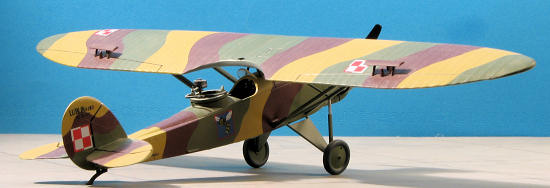 strut.
Fortunately, for the most part, there are pins on the pieces that fit into
corresponding holes so that is a huge help.
strut.
Fortunately, for the most part, there are pins on the pieces that fit into
corresponding holes so that is a huge help.
I also built up the engine assembly for later attachment. I really am not fond of the tiny exhaust stubs as even in 1/48 scale, they were a bit of a pain to apply. This was painted and set aside until later. Same for the main wheels.
| COLORS & MARKINGS |
Before attaching the wing, I painted the model. For this I
used Gunze Acrylics pretty much exclusively. During this phase of my model
building 'career', I was very much into Gunze paints and used little else. I
 painted
the colors starting from lighter to darker and masking after each color was
applied. I'm not sure if the real planes were so done, but it looks quite nice.
A very nice thing about Gunze paints is that if you need to do touch up work,
brush painted areas match those airbrushed pretty well.
painted
the colors starting from lighter to darker and masking after each color was
applied. I'm not sure if the real planes were so done, but it looks quite nice.
A very nice thing about Gunze paints is that if you need to do touch up work,
brush painted areas match those airbrushed pretty well.
| FINAL CONSTRUCTION |
Once the kit was painted, I completed the assembly of the bits that were left. This was the wing, the engine, the wheels and the rear machine gun. I also had to glue on the step and the little wings that helped to move the ailerons. Then the model was given a clear coat and the decals applied. I found them to be pretty good. A bit on the transparent side, but in register and with good stick.
| CONCLUSIONS |
Despite not being a subject that attracts a lot of modelers, it is a fine kit that with a bit of extra work (like drilling out the exhausts or adding the small amount of rigging), can be made into a real show stopper.
| REFERENCES |
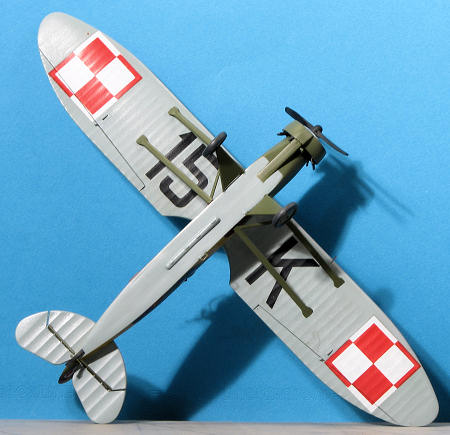 http://en.wikipedia.org/wiki/Lublin_RXIII
http://en.wikipedia.org/wiki/Lublin_RXIII
May 2011
If you would like your product reviewed fairly and quickly, please contact the editor or see other details in the Note to Contributors.
Back to the Review Index Page 2023